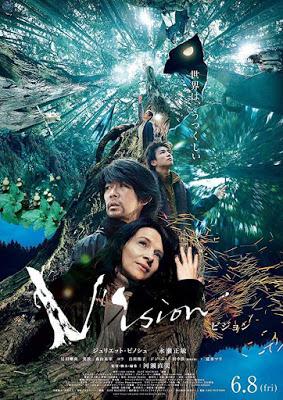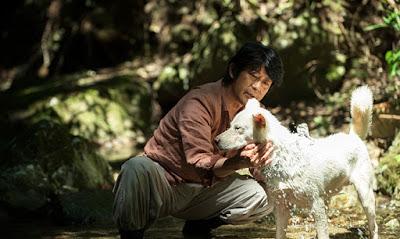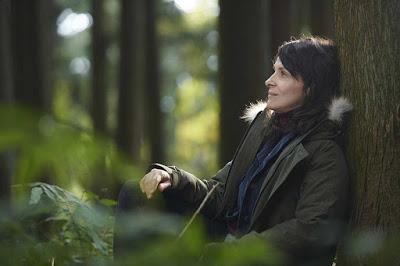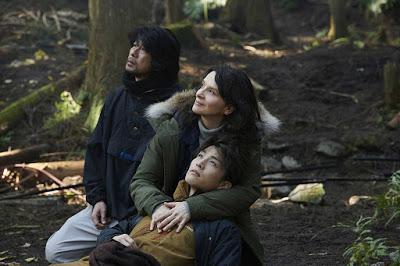
Most directors yearn to make one film at least that deals with science fiction in their careers; some succeed in making amazing products, most fail to make a lasting impact. Stanley Kubrick’s 2001: a Space Odyssey (1968), Andrei Tarkovsky’s Solaris (1972), Lars von Trier’s Melancholia (2011), and Godard’s Alphaville (1965) are memorable efforts by directors to deal with science fiction and come out trumps. They make a singular effort and rarely return to the genre. Others like John Boorman’s Zardoz (1974), Richard Fleischer’s Soylent Green (1973), Cornel Wilde’s No Blade of Grass (1970) or Robert Altman’s Quintet (1979) fumble in their attempts to make a lasting impact or while a host of other directors end up making make escapist, commercial, comic-book films like Star Wars or Back to the Future that will please the pop-corn eating audiences. Two major filmmakers whom I respect, attempted to make their latest films in the first category—Naomi Kawase with Vision (2018) and Claire Denis with High Life (2018), combining science fiction and philosophical food for thought. Both films figure among my top 20 films of 2018.

Aki (Mari Natsuki) the charming 1000-year-old, blind,
untrained, genetic resource collector
Ms Kawase’s latest two works Radiance (2017) and Vision (2018) deal with blindness and sight, physical and metaphorical. While Radiance dealt with a creative person losing his eyesight, Vision furthers the connection by Kawase first introducing a symbolic, metaphysical, fictional 1000-year-old blind woman who collects herbs—an endearing untrained “plant geneticist”( who can see the past and the future of the flora and humankind) named Aki (Mari Natsuki).Kawase’s original scripts are always amazing works in parts but she often fumbles when she tries to knit these concepts together.
Kawase goes on the same path further into science fiction by introducing a medicinal herb appropriately named Vision that blooms every 997 years (just 3 years short of Aki’s purported age) bringing forth spores that can heal pain and sadness in humans. The number 997 is a prime number adding to the mystique associated with numbers in mathematics. Radiance and Vision share the same lead male actor Masatoshi Nagase, a Kawase regular pick in recent years, adding to the connection between the afore-mentioned two films. The two films could form a diptych on human ability to see, connect and come to terms with nature during our life span.

Satoshi (Masatoshi Nagase) and his dog
In her film script, Kawase extends facets in science that are indeed true. There is indeed a flowering herb called Neela Kurinji (Strobilanthes kunthianus) that produces purple-blue flowers every 12 years on the grassy hills near Munnar, Kerala, India, catapulting the sleepy Munnar as the top destination in Asia for global nature lovers in 2018 when its hill slopes turned purple-blue. Interestingly, poets and literary works have also alluded to the connection of the Kurinji flower as a symbol of self awakening in a woman. The honey produced by bees feeding on this rare flowers’ nectar is supposed to be very healthy and tasty. Did Kawase pick an idea or two from these scientific facts? Kawase’s Japanese effort also recalls the notable 2017 Turkish film Turkey—Semih Kaplanoglu’s Grain, which won the Best Film award at the Tokyo film festival, another film on plant genetics.

The Neela Kurinji flower that blooms every 12 years on the hills
near Munnar, Kerala, India, much like the fictional Vision flower
that blooms every 997 years (The photograph is not from Kawase's film)
Kawase’s Vision deals with the past, present and future. It deals with association of nature and humankind. There are forests (recall Kawase’s The Mourning Forest made in 2007), trees and wind to help uplift the storyline to philosophical levels as in many Terrence Malick films. Vision has sequences that recall creation process in Malick’s The Tree of Life (2011). Kawase’s films are often geographically anchored to Nara prefecture (where the director grew up) in Japan, similar to Malick’s references to Waco and Texas in most of his films.

Jeanne (Juliette Binoche) absorbing the forest's beauty
In Kawase’s Vision, characters are introduced into the script and they exit the script without much of explanation. Frenchwoman Jeanne (Juliette Binoche) travels to Nara from France after stumbling on the rare herb Vision in her plant genetic studies. She connects with Satoshi (Masatoshi Nagase) and the blind woman Aki through a Japanese girl Hana (Minami) who leaves the tale/film abruptly. Aki seems to be expecting the arrival of Jeanne. Satoshi has a dog that has a role that evokes a mythical similarity to the dog in Tarkovsky’s Stalker and that dog dies enigmatically in Vision. A young man Rin enters the tale abruptly and the ensuing chemistry between the trio would bewilder most viewers. Satoshi has been living alone in the forest for the past 20 years with Aki living nearby. As the film progresses, Kawase gradually reveals Jeanne has been in Japan, interestingly 20 years ago. Kawase switches between science fiction and drama with a rare felicity. How then does Vision make sense to the viewer?

Satoshi, Jeanne and Rin
Clues to answer the questions comes from Kawase herself on the importance of connection: “It occurred to me when I was driving a car one day. Contemporary society may be perfecting a world in which we can live alone. In movies made on the theme of the Destruction of Humanity, a sudden explosion occurs or a virus arrives that causes the destruction. But what if that destruction takes place with our full acquiescence? It’s a bother to get involved with people. Life is easier without marriage or children. Rather than being attached to a company, there’s more freedom in working freelance, responsible only to yourself. Without contributing to your community, you can pay money and get all the extravagant services you desire. Thus the era has begun where people can live without seeking connections to others. But... Is that what humanity has been striving toward? Is this the “abundant future” promised by the accumulation of wisdom? I wonder. The exclusion of connection, refusing to pass on one’s genes, sharing none of your neighbour’s pain, a faceless society begins to be taken for granted, and beyond one’s life, nothing more is required. Isn’t this evidence that we have already quietly entered the Age of Destruction? If life forms exist elsewhere in the universe, why hasn’t a developed life form come to Earth to encounter our likewise developed humanity? There is only one answer. When a civilization develops too far, destruction begins. The phenomena mentioned above fit this theory. What influence does art have on humanity? Artists across the spectrum of genres have pursued this question through the centuries, but they have yet to guide us to an answer. No matter what exceptional art is employed, war has not been eliminated, while inequality and poverty rooted in the idea of stratification have not been wiped off from the Earth. However, when I place my hope in that potential and engage in creative activity that explores the role of art, I make discoveries within the realm of that film, and I share the doors that lead toward “true abundance”. This film spotlights the “discomfort” that emerges within contemporary society, while embracing our differences and suggesting the next moment that humanity should welcome.” (Source: Press kit for the film Vision)
By a weird coincidence, in the very year Vision was made, an exceptionally well-made, delicate small-budget film was made in USA on the Japanese diaspora in the US state of Hawaii called August at Akiko’s directed by Christopher Makoto Yogi, making his debut as a feature filmmaker. Both films deal with Japanese culture, and both deal with interactions between the young and the old to live a connected life with humans, nature and the metaphysical world. Kawase’s film is of course far superior of the two, though convoluted as a narrative.
Vision might not be Kawase’s best work, yet it is one the best films of 2018. Her flawless works remain Shara, The Mourning Forest, Still the Water and Sweet Red Bean Paste. But few will dispute the awesome cinematography of Arata Dodo and the charming music of Makoto Ozone that lifts the quality of this Kawase film above her other works. Both are teaming up with Kawase for the first time. That combination offers pure delight for the senses.
P.S. Kawase’s earlier films Shara (2003), The Mourning Forest(2007), Hanezu (2011), Still the Water (2014), and Sweet Red Bean Paste (2015) have been reviewed earlier on this blog. So too, Kaplanoglu’s Grain (2017) and Malick’s The Tree of Life (2011) (Click on the names of the films in this postscript to access the reviews.) Vision is one of the author’s top 10 films of 2018.

